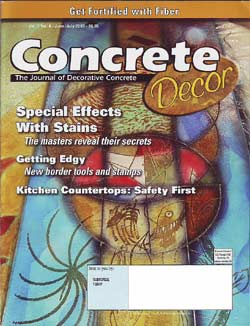
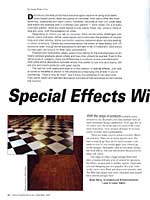 |
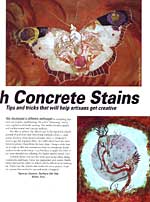 |
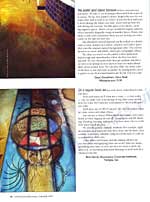 |
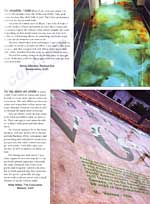 |
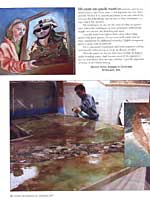 |
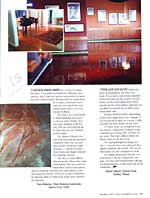 |
Special Effects with
Concrete Stains
Tips and tricks that will help
artisans get creative
BY SUSAN BRIMO-COX
Decorative concrete artists have become quite creative in using acid stains, water-based stains, dyes and paints on concrete. Acid stains offer the most earth-like, weathered and warm colors. However, because of their iron oxide base, acid stains are available only in a limited color palette - earth tones. For a virtually unlimited palette, there are water-based acrylic stains. Dyes, too, come in more or less any color, with the exception of white.
Depending on whom you talk to, however, there can be some challenges with acrylic stains and dyes. While water-based stains eliminate the problem of neutralizing acid stain residue, some contractors express concerns about acrylics peeling in some conditions. Others are concerned about the colors of dyes fading with UV exposure, even though some dye products are said to be UV-resistant. Acid stains, for their part, are known for their color permanence.
Experienced contractors wisely spend time talking to the manufacturers of different colorant products about where and how they should be applied. Even in the same product category, there are differences in products across manufacturers. And while some decorative concrete artists may prefer to use only acid stains, others mix and match products with great results.
The real fun with stains and dyes is in the creation of special effects. Just look at some of the effects shown in the photos accompanying this article. If you're wondering, "How'd they do that?" you'll enjoy this sampling of tips and tricks from some clever and talented decorative concrete artists and experts from across the country.
With the range of products available today, artisans in the decorative and faux markets have almost unlimited design capabilities. Years ago, five or 10 colors were the norm and you 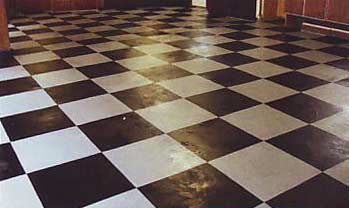 could make variations from there. Now artisans demand 50 or more colors to make their combinations.
could make variations from there. Now artisans demand 50 or more colors to make their combinations.
There are many ways to achieve creative effects on concrete. There are so many options now. We have a neutral gel that can be used in stains, colorants or dyes so you would apply your colored gel in the designs, then apply color to the entire surface for vivid effects. You can also reverse the process for deep rich colors.
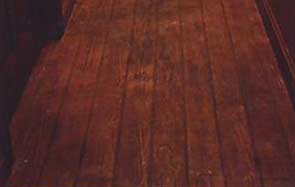 For logos or veins a large syringe filled with dyes or stains will give a lot of control for spectacular effects; air-powered is another option. Vinyl stencils and antiquing are very popular this year. Stain or dye your entire floor, put down your stencils, take Tru Blue and adjust your color, then pull your stencil for a custom antique floor.
For logos or veins a large syringe filled with dyes or stains will give a lot of control for spectacular effects; air-powered is another option. Vinyl stencils and antiquing are very popular this year. Stain or dye your entire floor, put down your stencils, take Tru Blue and adjust your color, then pull your stencil for a custom antique floor.
Brad Berg, Architectural Enhancements,
Lake Crystal, Minn.
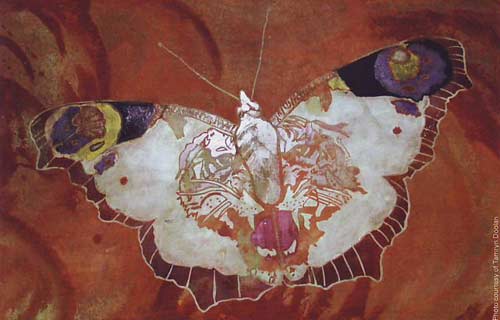
We developed a different technique for stenciling that does not require sandblasting. We call it "flattooing," and it uses a gelled acid for the etching. The method works equally well on horizontal and vertical surfaces.
 I'm able to achieve the effects I get by laying down a background of acid stain and then using multiple colors - acid stains, acrylics, water-based colorants, dyes - whatever I need to get the required effect. As I add colors I seal the ones below to protect them from the next steps. I keep a cloth handy to wipe or blot any extraneous drips or extraneous brush strokes on the sealed areas. I use brushes to apply the color the more detailed the coloring, the higher quality brush I use.
I'm able to achieve the effects I get by laying down a background of acid stain and then using multiple colors - acid stains, acrylics, water-based colorants, dyes - whatever I need to get the required effect. As I add colors I seal the ones below to protect them from the next steps. I keep a cloth handy to wipe or blot any extraneous drips or extraneous brush strokes on the sealed areas. I use brushes to apply the color the more detailed the coloring, the higher quality brush I use.
I almost always use acrylics with acid stains when doing trademarks and logos. I also use pigmented acid stains, Smith Paints and acrylic colors to achieve all the effects we're looking for. There's no one system that works for every project. Find the system that works for you and make it happen!
Tamryn Doolan, Surface Gel Tek,
Mesa, Ariz.
We prefer acid stains because of their transparency and depth. We like to use techniques borrowed from watercolor artists. We lay thin painter's plastic dropcloths into the wet stain either wall to wall or in "rivers" across the floor and leave it down during the entire cure time. Gases well up from the slab during the reaction; this lifts areas of the plastic, creating negative spaces. Hence you get wonderful organic patterns which resemble dragonfly wings or mottled leaves. Plastic also helps to ease color transitions when you are mixing two stain colors on the slab wet-into-wet.
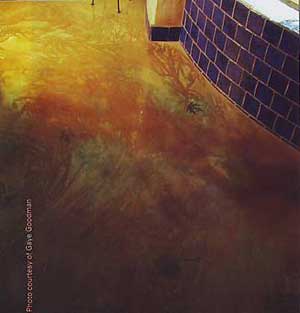 Any absorbent natural material can be soaked in a darker color of stain, drained in a plastic colander, and laid or sprinkled onto the original stained background color. Our current favorites are straw and alfalfa, which give calligraphic effects.
Any absorbent natural material can be soaked in a darker color of stain, drained in a plastic colander, and laid or sprinkled onto the original stained background color. Our current favorites are straw and alfalfa, which give calligraphic effects.
We often use artist's acrylic paints to faux-paint over bucket rings and stain blotches where the floor has been patched. We mix the paint with clear gel medium and dab it on with a sea sponge in thin layers to keep the multicolored effect of the stained floor. We can also "shift" the entire color of the floor in one direction or another by adding artist's acrylic paints to our clear water-based sealer for the first few coats.
Gaye Goodman, Faux Real,
Albuquerque, N.M.
On a regular basis we use acid stains, water-based stains and dyes.
With acid stains we'll often use a resist - a clear sealer - that we apply with a sea sponge or rag, then come over it with the stain. We'll also use eyedroppers to bleed stain upon wet stain.
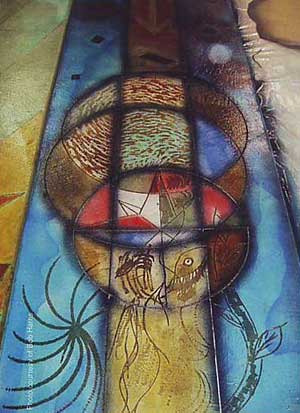 With dyes, use an HVLP sprayer. We use torn paper edges for veins, waves and other effects.
With dyes, use an HVLP sprayer. We use torn paper edges for veins, waves and other effects.
You can use a variety of faux finish techniques with waterbased acrylics: ragging on and off, sponging on and off, blending, bleeding, layering, and more. You have more time to work with water-based acrylics.
We also frequently combine methods. For example, apply and acid stain as a base color and then clean, and for more color contrast or intensity consider using an acrylic stain or a dye or a combination of the two.
Other effects techniques include ripping old bed linens into strips and applying them wet or dry onto wet stains, sprinkling kitty litter or rock salt on a wet stain to draw the stain to it; or scattering aluminum shavings on acid stain for a chemical reaction.
Bob Harris, Decorative Concrete Institute,
For versatility, I make a lot of my own acid stains. I research old formulas from the 1930s and 1940s. I like acid stains because they don't fade or peel. They have permanency and they are fun to work with.
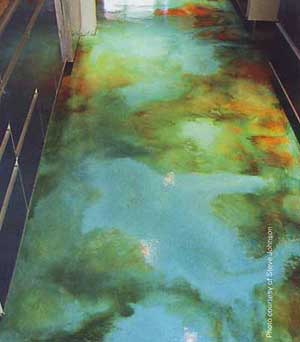 I'm more of a subtle user of effects. I use a lot of water. I wet the surface to have movement of color, like a watercolor. Sometimes I spray the surface; other times I puddle the water. Depending on how much water you use you can have very subtle or rich-looking effects, or something that looks wack - you can do whatever you want to do.
I'm more of a subtle user of effects. I use a lot of water. I wet the surface to have movement of color, like a watercolor. Sometimes I spray the surface; other times I puddle the water. Depending on how much water you use you can have very subtle or rich-looking effects, or something that looks wack - you can do whatever you want to do.
I'm very conservative with techniques. I use crumpled tissue paper to create a crinkly leaf effect. I use sand to block out areas - and that can give real cool effects when using multiple colors. Sawdust does the same as sand to block an area better.
We will be seeing change in the marketplace as dyes get better. With dyes you'll be able to get colors you can't get now with acid stains.
Steve Johnson, Decked Out,
Sacramento, Calif.
For me stains are similar to watercolors. I use sealers as resists and metallic salts to create more intense or less intense areas. The only difference between stains and watercolors is that stains variegate through chemical reaction as well as through the application technique.
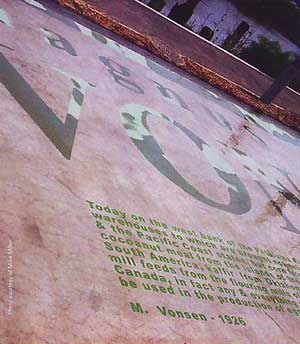 You can always count on acid stains to do what you didn't count on them to do. Their variegation and unpredictability is what's both good and bad about them.
You can always count on acid stains to do what you didn't count on them to do. Their variegation and unpredictability is what's both good and bad about them.
So, if you're going to be in the stain business, you also need to be in the dye and tint business. Dyes' consistency and penetrating and transparent characteristics give you fine color control you can't get with stains. Tints offer color consistency as well as opacity; an ability to hide.
For tinting over acid stains, I purchase pigments as a raw material - super-finely ground pigments, essentially the same chemicals and colors as in paints and integrally colored concretes but so finely ground that they penetrate into the pores. I generally mix pigments with a solvent carrier and a small amount of acrylic resin to apply.
Mike Miller, The Concretist,
Benicia, Calif.

We create site-specific murals on concrete, and we use Smith Paints Color Floor stain - the pigments are very finely ground. We buy it in concentrated form so we can control the viscosity for airbrushing, wet-on-wet or other techniques, using it much like an artist.
The techniques we use are the same as a fine art painter uses: watercolor techniques, acrylic techniques, airbrushing, stipple, wet-on-wet, dry brushing and more.
I usually work from light to dark colors when using paints with good opacity, or vice versa with paints that are more transparent for additional versatility. Highly transparent paints I apply with an airbrush.
For a coin mural I used black and white pigments and layered metallic silver on top to create an illusion of relief.
With the paints we use we don't have residue cleanup or sealer-bonding issues. And, because most of the pigments I use are iron-based, they are very colorfast. I give the pigments 24 hours to dry before sealing.
Steven Ochs, Images in Concrete,
El Dorado, Ark.
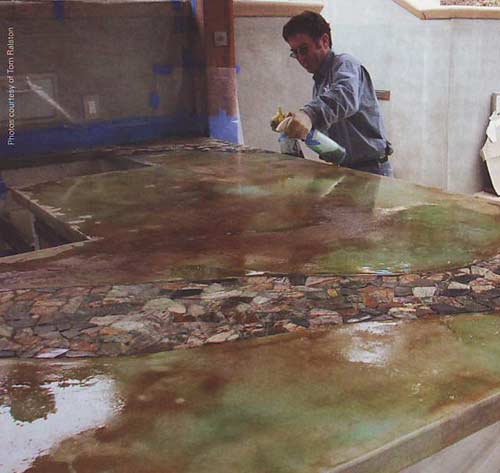
I use acid stains made by a variety of manufacturers. I use different brands for different color options, and I have also gotten raw product to make my own custom colors. Because they are made from iron oxides, acid stains stain concrete very much like iron oxides stain rocks it's very natural-looking.
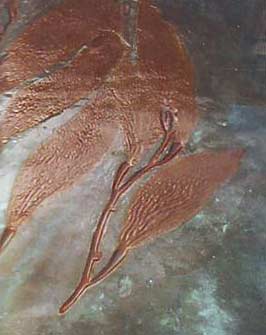 We prefer not to use brushes when applying acid stains - we use spray bottles. You can spray multiple acids this way, and the mottling you get by spraying you can't achieve with brushes.
We prefer not to use brushes when applying acid stains - we use spray bottles. You can spray multiple acids this way, and the mottling you get by spraying you can't achieve with brushes.
I've thrown Miracle-Gro into acid stains for an intensely turquoise color. You can use shoe polish, wood dyes, and Sharpies - whatever stains your hands you might consider for staining concrete.
We like to create effects that are artful, effects that come from nature. We may make an impression stamp from nature, such as seaweed, and then use acid stains to color the stamped concrete. We'll use acrylics sometimes for special colors or when acid stains don't perform as expected.
Tom Ralston, Tom Ralston Concrete,
Santa Cruz, Calif.
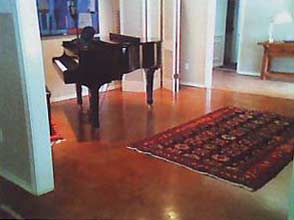
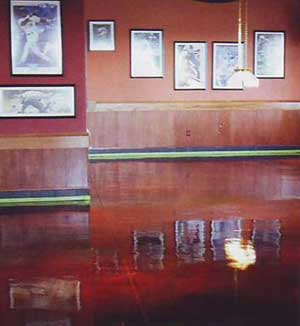
I think acid and acrylic stains are good, depending on the effect you want. If you want a distressed, mottled look acid stains are the answer. Acrylic stains, on the other hand, have really opened up the color palette, and you can use them as a touch-up or where acid stains don't take.
You get different effects depending on how you apply stains; for example, if you broom on or spray on a stain. Coffee grounds put little specks in the color.
To make veins, lay string down on the surface. Long strips of plastic wrap crinkled up in a long tube will also create veins. The stain collects where the plastic rests on the wet stain.
Try taping designs or using stencils - you can stain one color and then lightly sandblast the stencil. You can dilute stains, too, for a washed-out look.
No matter what stain you use, it is important to choose compatible coatings. Call the stain manufacturer and get recommendations to save time and avoid headaches.
David Tatom, Chem-Coat,
Dallas, Texas
